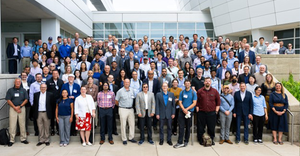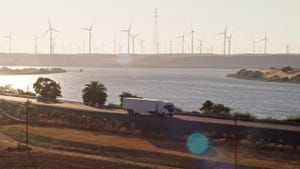When Recycling C&D: Makes Sense
May 1, 1998
Sharon Colley
If you don't have the right tools, generating a profit from a construction and demolition (C&D) debris recycling operation can be as difficult as crushing a one-ton slab of concrete with your fist. A minor exaggeration, perhaps, but without forethought toward aftermarkets, regional viability and equipment needs, your operation could grind to a halt before you open for business.
Pushed by escalating tip fees and state laws, increasing numbers of waste management professionals are starting to experiment with C&D recycling without knowing exactly what they will be taking on.
How lucrative any C&D recycling facility can be varies, reports James McElvenny, manager of business development at Weaver Industries, Fresno, Calif., and a C&D recycling consultant. Each facility's unique regional situation influences how much profit a recycling operation can expect to make, he says.
Before you begin recycling, you first must know your markets. Jonathan Hixon, vice president of Environmental Resource Return Corp. (ERRCO), Eping, N.H., can't stress enough how researching local markets can make the difference between a lucrative facility and a lackluster operation.
The Monterey Peninsula Landfill, Monterey, Calif., is one of those sites that has taken on the C&D recycling challenge. Overall, site diversion is 25 percent to 30 percent, with 50 percent of that figure being diverted within the building.
Although the landfill has participated in some C&D recycling for years, it only built its recycling facility to abide by California law AB939, says General Manager David Myers. The public agency sold $15 million in bonds to pay for the recycling facility and for other improvements. The efficient, extensive operation does not bring a high profit, but as a public facility aiming to comply with state law, it meets its goals.
While Myers notes that permits for C&D facilities (recycling or not) tend to be less stringent than those for regular landfills, McElvenny cautions that local site and permit assignments will affect profitability.
Hixon, who works for one of the largest private C&D recycling operations in New Hampshire, and Bill Proud, the former owner of Refuse Management (now Material Recovery Services Inc.), Eau Claire, Wis., both note that permits were initially difficult to attain because their recycling facilities were the first in their area.
"Going into C&D recycling with your eyes open" is essential, McElvenny says, because planning can make or break the operation. For example, while high tip fees might be the impetus for a manager to consider recycling C&D, the fee amounts can fluctuate over time as economic conditions change, he says.
Since most recycling costs are fixed, tip fees and materials are where profits can be made, Hixon says. However, a C&D operation based on fees alone won't be as successful in the long run as those which also sell their end products.
Know Your Aftermarkets Aftermarkets for the materials can mean the difference between a profitable recycling facility and a bankrupt, debris-filled building.
A consistent market for recycling products is a recycling facility's lifeblood. However, since aftermarkets can vary regionally, fledgling recyclers should know the local market as thoroughly as possible, Hixon says.
ERRCO's 22,000-square-foot processing building produces four products: wood chips to burn for electricity, a road-based aggregate, fine dirt to give away as landfill cover and metal to sell to a metal recycler. Hixon says he receives calls almost daily from customers who cannot sell the recycled wood chips they produce.
Planning for the appropriate equipment and for market realities would help these other operators be more successful - or realize that C&D recycling cannot be profitable for them in the first place.
An operator determined to engage in C&D recycling, but which has low tonnage, should consider focusing on one market, McElvenny suggests. By creating one product with high return, a smaller recycler can maximize profits.
Potential competition should be considered as well, McElvenny says. When other landfills or facilities enter the picture, profits may be altered. For instance, the Monterey landfill has recycled concrete and asphalt debris for 15 years, but has seen a drop in the volume of debris recently because another landfill has started charging little or nothing to take the same material.
Surveying present and future recycling and landfill sites will give an operator a better idea of how profitable his operation might be. Also, research on the history and likelihood of future tip fee fluctuation will help a recycling manager gauge potential profits - or problems.
Surveying competition from virgin material is important in planning, McElvenny says. For example, if wood chips will be your end product, then you should research the availability and price for virgin chips. If they are readily available, then the demand of the recycled and inevitably contaminated version will be lower, as will be their price. Don't just assume that a market will exist.
Separating debris effectively is essential to maximizing profit, McElvenny says. Some organizations offer financial incentives for those bringing separated materials. For example, the Bourne, Mass., Department of Public Works recycling center charges $50 a ton for C&D but only charges $10 a ton for sorted material.
Recycling since July 1996, the site offers a lower tip fee for brush and stumps, brick, asphalt and concrete, and straight metal loads. While some sorting occurs at the face of the facility, the landfill primarily separates the debris and then receives bids from outside contractors to handle processing.
Ensuring that enough material is available to sustain the plant is important, notes Hixon, whose bread-and-butter is debris from older buildings in the area that are being demolished.
Equipment also can make a big difference in profitability. But for those new to C&D recycling, determining the right kind of equipment can be an enigma, says Proud. He suggests seeking guidance from C&D recycling veterans before laying down cash on equipment that you might not need.
Whatever equipment you select, make sure that your system cleans materials thoroughly, Hixon stresses.
A good C&D operation is by definition a high-tech or medium-tech separation facility, according to McElvenny. Low-tech seldom can move enough tonnage to make the recycling profitable. However, in some areas where labor is cheap, a facility emphasizing labor over high tech might be just as successful.
While finding aftermarkets Is crucial, intense and time-consuming, Hixon states that few will commit to working with a C&D operation until the facility is actually built. Despite this aftermarket Catch-22, all private operators stress that establishing markets are essential to an operation's success.
Sometimes, a facility is fortunate enough to have a market already present in the community. For example, the Monterey landfill began recycling clean, untreated wood and green waste about five years ago because a burning plant needed the wood. The plant would pay $4 per dry ton and grind the wood itself - a fine deal for the landfill. (The plant's recent closing, however, has since caused Monterey to search for alternate markets.)
Fifteen years ago, the Monterey facility began recycling concrete and asphalt because a granite construction company offered to crush and pay if the materials were pulled. Although competition has since cut into the market, the facility still continues to pull and store the materials for the company to crush.
Often, markets can be located by surveying your region's needs. For example, if wood is a plentiful C&D material, then the availability of virgin and recycled wood chips should be explored. If recycled wood chips are more cost-effective or plentiful than virgin chips, that's your market.
Vertical Integrated Recycling The ideal C&D recycling operation is "vertically integrated recycling," McElvenny says. Vertical integration gives the operator control over every aspect of the recycling process, minimizing cost and maximizing profits. The facility uses its recycled materials to create a finished product, which it then can put into use. This process keeps the facility's aftermarket free from external control.
For example, a demolition contractor takes down a building with its own equipment and transports the debris to the recycling center (eliminating the center's cost of buying and transporting the materials).
At the recycling center, wood is processed into chips with equipment owned by the facility. The chips are sold internally to another division and made into a product called "hydromulch." Thus, the facility has brought the C&D to its own center, processed it using its own equipment and created a product for its own use.
This ideal vertical integration allows the recycling center to profit at every stage of the process. By eliminating fees for equipment rental and by controlling the market, the facility would not be at the mercy of other competition or changing conditions.
While an extensive facility may yield the ultimate in lucrative C&D recycling, less elaborate operations also exist successfully. Regardless of operational extent, the most successful facilities are the ones that invest heavily in both planning and equipment. For example, ERRCO does not provide demolition or transportation, but the 100-acre facility processes more than 175,000 tons of C&D annually.
Although C&D recycling offers a new and potentially profitable center, the same basic recycling rules apply: You must understand the unique aspects of your community, the market for the materials, the potential waste stream and your own capabilities before jumping off the wrong end of the building.
You May Also Like


